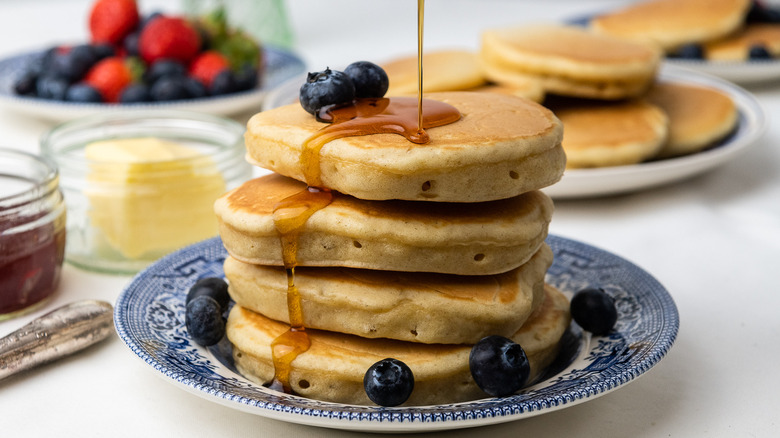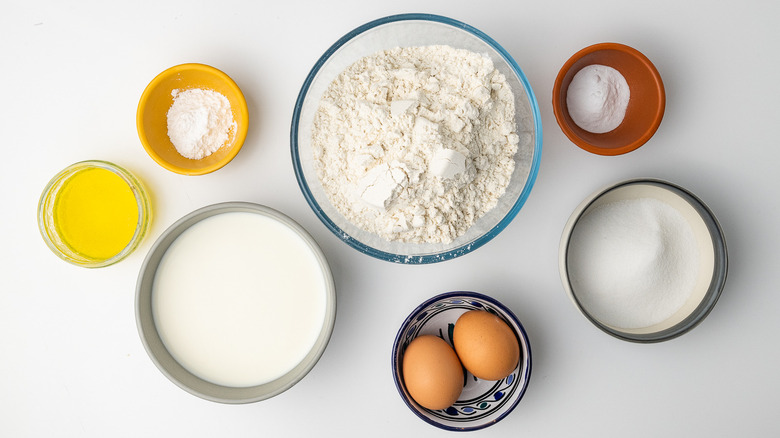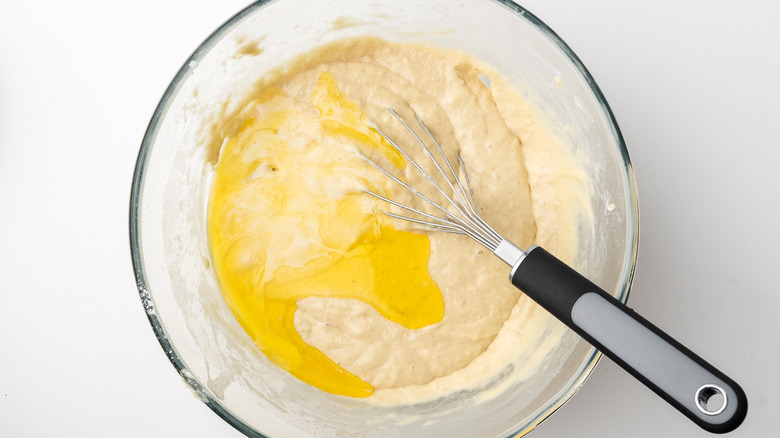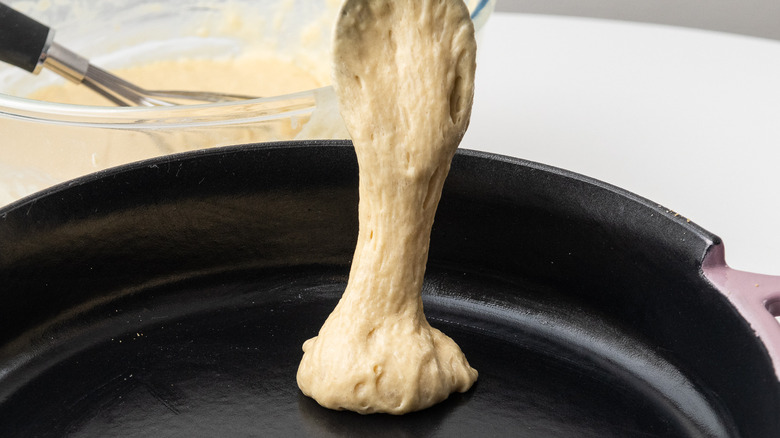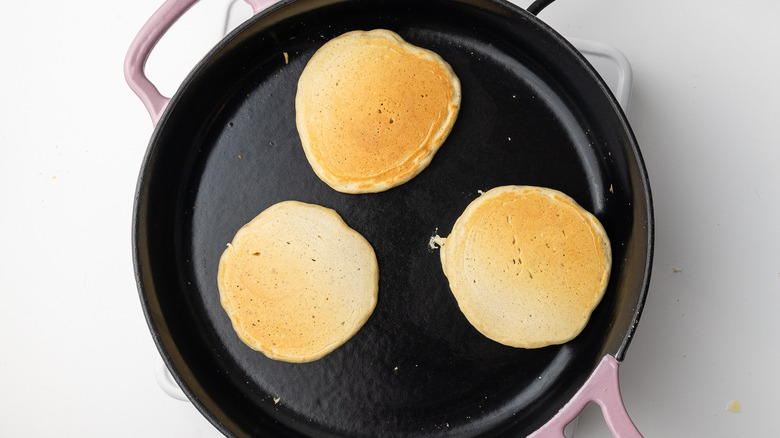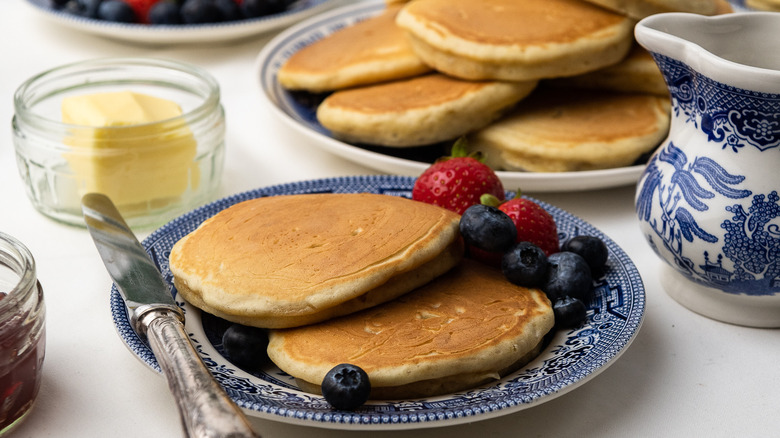Queen Elizabeth II's Drop Scones Recipe
If you love digging into a warm stack of freshly made pancakes, then you might have something to learn from the late Queen Elizabeth II. Back in 1960, Her Majesty shared her drop scone recipe with U.S. President Eisenhower, who had quickly become a fan of the treat during a recent visit. If you're not into crumbly scones, you'll be glad to know that drop scones, aka Scotch pancakes, are more akin to the fluffy dish commonly served for breakfast. Indeed, recipe developer and food photographer Jennine Rye from The Marshside Pantry points out "they are similar to American pancakes really, and you can never go wrong with a pancake."
While the queen left excellent notes for President Eisenhower, Rye put it all to test and includes a few adjustments to make it foolproof. In true British royalty fashion, Her Majesty's recipe used quantities such as "teacups" to measure out flour and milk. With Rye's help, these drop scones are an easy option to prepare in the morning or for afternoon tea. And just like pancakes, you can serve them with all of your favorite toppings.
Gather the ingredients for Queen Elizabeth's drop scones
If you spontaneously find yourself craving drop scones (and the queen's recipe no less), you'll be glad to see that the ingredients are possibly already among your pantry staples. You'll need superfine sugar, which per its name, is just finely ground granulated white sugar. Next, bring your eggs to room temperature before incorporating them into the recipe. Whole milk is used to thin out the batter, which gets its bulk from all-purpose flour. Meanwhile, bicarbonate of soda (aka baking soda) and cream of tartar help the scones rise. Finally, melted butter provides just the right amount of fat to make the drop scones pleasantly moist.
Per the queen's notes, replacing the superfine sugar with golden syrup or treacle "can be very good, too." Meanwhile, Rye encourages further experimentation: "They are also delicious with different flavorings added to the batter, such as orange zest or cinnamon — have fun with them."
Combine the ingredients for the batter
Set out a large bowl to make the batter. Add in 4 tablespoons of superfine sugar, two eggs, and ¾ cup of whole milk. With the help of a balloon whisk, beat the contents until everything is well combined.
Next, measure out 3 cups of all-purpose flour (which, we've determined, is more or less the equivalent of the queen's "4 teacups"), 2 teaspoons baking soda, and 3 teaspoons of cream of tartar, and add them into the bowl with the wet ingredients. Keep mixing the ingredients to form a thick paste. Rye remarks that this step "will be quite labor intensive," and indeed, in her letter, Queen Elizabeth II noted that "the mixture needs a great deal of beating."
Once the texture is suitable, slowly pour in some additional milk, little by little. The desired batter should be smooth and slowly drip off a spoon when you scoop it up. "If it is too thin and runny, it won't hold its form when dropped into the pan," Rye warns. Discard any excess milk and gently fold in 2 tablespoons of melted butter.
Drop the batter onto a hot griddle
You'll want to cook the batter right after you prepare it, according to Her Majesty, who wrote in her letter to Eisenhower that it "shouldn't stand about too long before cooking." Although drop scones are originally intended to be cooked on a griddle, Rye notes that using a large cast-iron pan will produce excellent results too. Notably, these aren't baked in an oven as with other styles of scones.
Make sure to first heat the griddle or pan over low to medium heat. Once it is hot, drop a few heaping tablespoons of batter onto the surface. Leave a couple inches of space between each scone, since they do tend to spread as they cook. Consequently, you'll have to work in batches to cook all of the scones.
Flip the scones and cook the second side
After about 2 minutes, you'll notice some bubbles forming on the surface of the batter. Carefully lift the edges of the scones to see how the bottoms are doing. Once they turn golden brown in color, flip each scone over and cook it for 1 more minute on the other side.
Transfer the drop scones to a plate and drape a tea towel over top to keep them warm as you continue to cook the remaining batter.
Serve Queen Elizabeth II's drop scones with classic toppings
There are plenty of ways to enjoy these delicious drop scones depending on your preferences. Rye recommends classics like butter, jam, golden syrup, maple syrup, and fresh berries. Given their similarity to pancakes, pretty much anything that goes with the classic breakfast dish works well here too. That being said, you might want to channel the queen and keep your toppings restrained, in order to savor these delicate drop scones for what they are. On more traditional scones, Her Majesty was fond of sweet jam and clotted cream, as shared by former royal chef Darren McGrady (via New York Post).
If you have leftovers, Rye advises storing them in a sealed container in the fridge for up to three days and reheating them before digging in. All the same, she shares, "it would be my recommendation to only make as many as you need and store any remaining batter in the fridge, as they are always at their best when fresh!" Alternatively, she adds that the drop scones can be frozen as long as they are properly wrapped.
Queen Elizabeth II's Drop Scones Recipe
In 1960, Queen Elizabeth II wrote a letter to President Eisenhower that contained her personal recipe for drop scones. Here's how to make the teatime favorite.
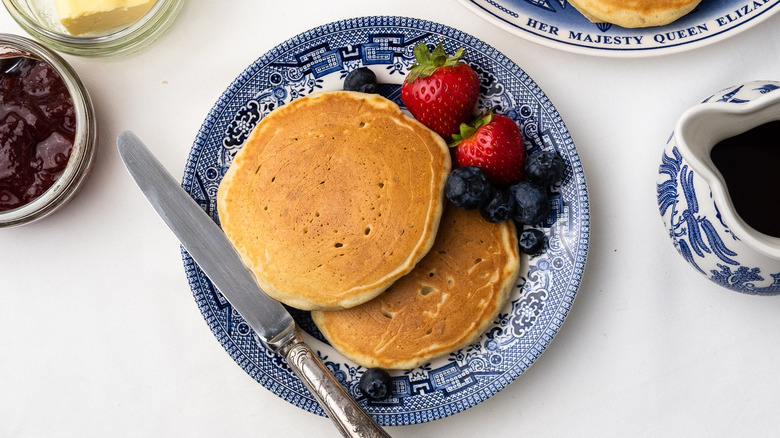
Ingredients
- 4 tablespoons superfine sugar
- 2 large eggs, room temperature
- 1 ½ cups whole milk, divided
- 3 cups all-purpose flour
- 2 teaspoons bicarbonate of soda (aka baking soda)
- 3 teaspoons cream of tartar
- 2 tablespoons butter, melted
Optional Ingredients
- butter, jam, golden or maple syrup, or fresh berries (for serving)
Directions
- In a large bowl, combine the sugar, eggs, and ¾ cup of whole milk.
- Using a balloon whisk, beat the ingredients until they are well combined.
- Add the flour, bicarbonate of soda, and cream of tartar to the bowl. Mix them into the wet ingredients until a thick paste forms.
- Add the rest of the milk a bit at a time while whisking, until the mixture is smooth and slowly drips off a spoon.
- Discard any remaining milk and fold in the melted butter.
- Heat a griddle or large cast-iron pan on medium-low heat.
- Once the cooking surface is pre-heated, drop a few heaping tablespoons of batter into the pan. The drop scones will spread as they cook, so leave 1 to 2 inches between each scone and cook in batches if need be.
- After about 2 minutes, the tops of the drop scones will begin to form bubbles. Gently lift the scones to check that the bottoms are golden brown, then flip them over to cook the other side for 1 minute.
- Once cooked, place the drop scones onto a plate and cover them with a tea towel to keep them warm while you cook the rest.
- Serve the drop scones with classic sides such as butter, jam, golden or maple syrup, and fresh berries.
Nutrition
| Calories per Serving | 268 |
| Total Fat | 6.0 g |
| Saturated Fat | 3.1 g |
| Trans Fat | 0.1 g |
| Cholesterol | 58.7 mg |
| Total Carbohydrates | 44.7 g |
| Dietary Fiber | 1.3 g |
| Total Sugars | 8.5 g |
| Sodium | 354.0 mg |
| Protein | 7.9 g |
